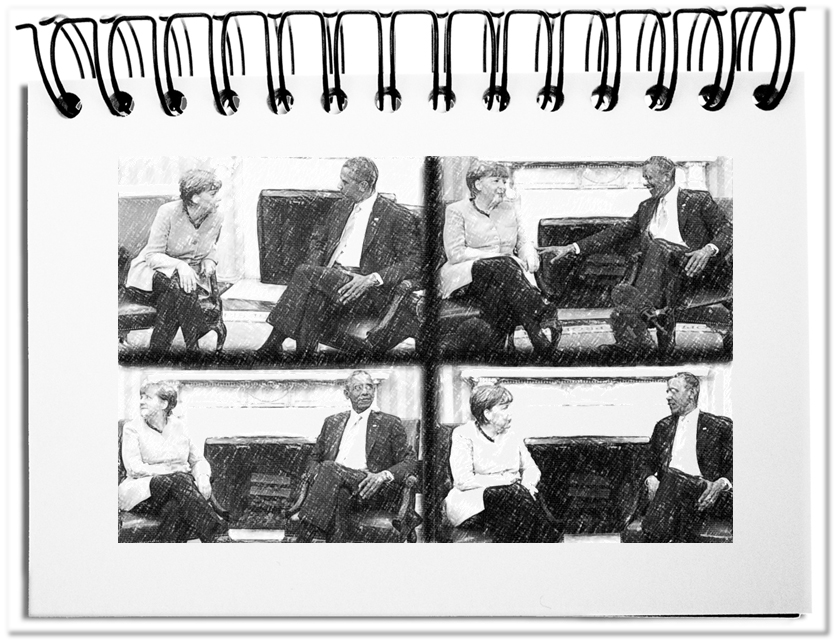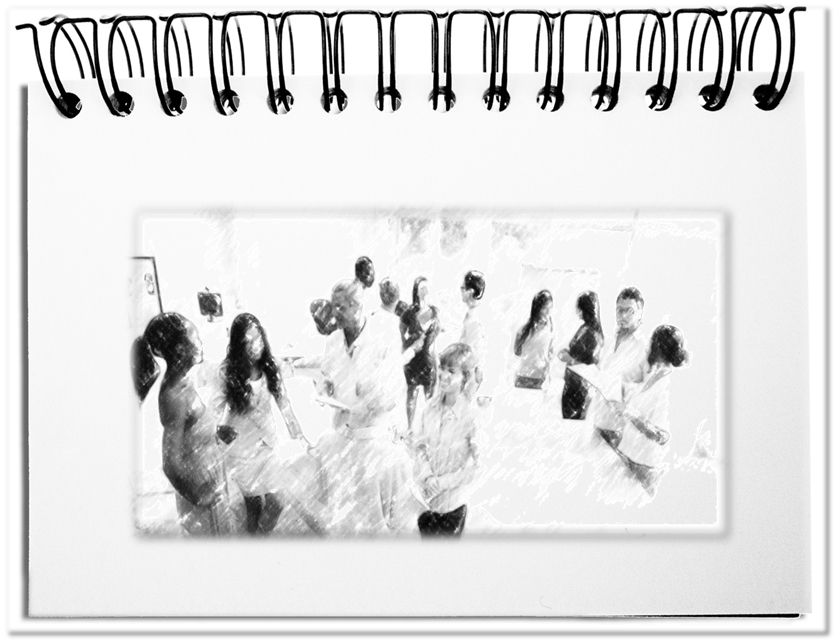Over time we developed the conviction ‘Seeing is believing’. This means that one believes in the existence or truth of something, which one saw with the own eyes. Some are already convinced, when they learn about the seeing through second-hand. Images are an effective way to convey a message. There are rock paintings that already used the figurative representation thirty thousand years ago. As time went by the representations became more and more realistic. Today, we can participate in current developments even through moving pictures with original soundtrack and in real time. The picture is taken as proof. Many forget that the two-dimensional medium of a picture distorts reality with its perspective, frame and the moment of the taking. The consequence is that a picture says more than thousand words – sometimes even wrong ones.
In the course of the Ukraine crisis the above photographs were taken in a meeting between Chancellor Angela Merkel and President Barack Obama. Different photographs of the meeting appeared subsequently in several newspapers. We still trust the journalists as the last bastion of objectivity. The ethos of journalists, to always spread objective truths, should actually lead to reliable news. Let’s forget the special cases of the controlled, non-military war correspondents (so called embedded journalists) and the quasi-state-run press, since they are obviously propaganda. The associated attempt of the historical manipulation already began with Caesar, continued with Charlemagne and the dictatorships of the twentieth century, until today.
Let’s focus on respectable journalism that spreads news to the best knowledge and belief. In order to define a limit, there are some non-binding rules.
- On the one hand news should be confirmed by at least two independent sources
- On the other hand balance should be ensured by the fact that both sides of a conflict should be reported.
You find further aspects here: http://en.wikipedia.org/wiki/Journalism_ethics_and_standards.
A picture cannot fulfill the two rules.
- On the one hand a picture is naturally from one source, the camera.
- On the other hand the picture represents just ONE cutout of the reality that represents only the fraction of a second.
For these reasons a picture is always one-sided and unbalanced.
If we now look at the scribbles, we see four pictures of the same meeting, which were taken within a few minutes. Each picture creates another impression. What are the reasons to select a picture for publication? By looking at the procedure, from taking a picture to publishing, we encounter many filters.
- Taking the picture
Photographers are the first filter. They decide the point of view, the cutout and the moment of the capture. Usually they photograph several photos within a short period. Subsequently, they select the photographs that fulfill the technical requirements – the requested sharpness and brightness of the picture. Additionally, they select images with regular gestures and facial expressions. Eventually the picture shown above end up in the agencies or media,. - Distribution
An agency is a broker for pictures and news, e.g. Reuters, DPA, ITAR TASS. They buy photos and offer them together with the agency message. The agency is acknowledged as an official source for the media. If two agencies provide the same message, the first rule is fulfilled. This makes the news item to reliable news. The selection criteria for the images are thereby hard to comprehend. In any case the picture selection reduces the message to one defined point of view. - Publication
The media editors (print, on-line, TV) had their own reporters in former times. That way, they could distinguish themselves from other media providers. Nowadays you hardly find salaried photo reporters. The photos are mostly bought directly from the freelance photographer or an agency. The advantage of an agency is the bundling of the picture with the press release. For cost reasons only the pictures are bought that are eventually published. The editor determines the ‘proof’ for the article by selecting the images.
Eventually the observer decides on its impression. Now look at the sketches above and consider, which picture you would buy!
About the mentioned meeting, on February 9th 2015, different pictures were used in different publications. What impression do the individual pictures create? On the left above? On the bottom left? On the top right? On the bottom right? And what was the real atmosphere of the meeting? Who might know.
In any case, people decided with the selection of the image which impression should generated among the viewers. A picture is worth a thousand words that do not necessarily correspond to the truth.
Bottom line: The times of ‘seeing is believing’ are probably over. Each event has any number of pictures that do not clearly express the real happening. Even blurred mobile phone photographs are used today, in order to convey a message to the public that cannot be guaranteed by the two rules. There is no other choice than dealing critically with these ‘proofs’ and to always consider the possibility that the message is wrong – whether we are deliberately manipulated or not.
P.S.: Do you remember the posed politician photo of the Charlie Hebdo demonstration?


